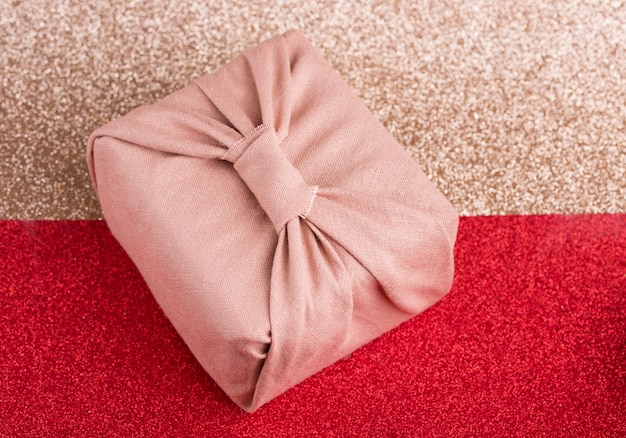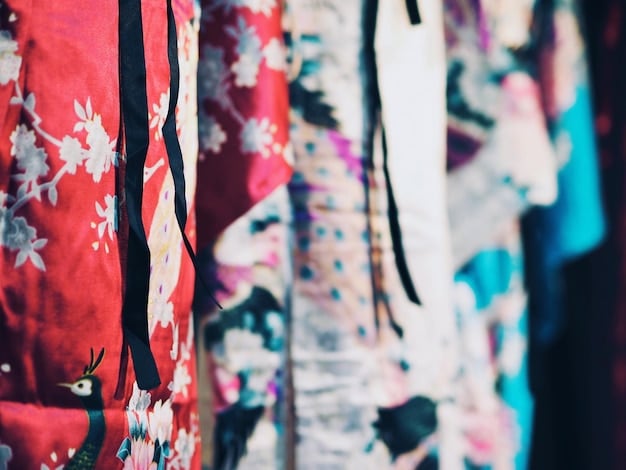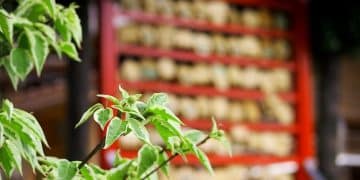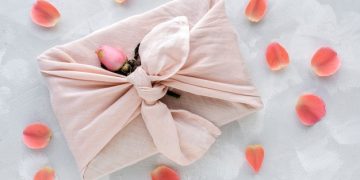Furoshiki: US Shopper’s Guide to Eco-Friendly Japanese Gift Wrapping

Furoshiki, the traditional Japanese art of fabric wrapping, offers American shoppers an elegant and sustainable alternative for gift presentation, leveraging versatile textiles to create beautiful, reusable packaging for various occasions and items, embracing eco-conscious practices while honoring Japanese cultural heritage.
For US shoppers looking to elevate their gift-giving while embracing sustainability, understanding The Art of Furoshiki: A US Shopper’s Guide to Eco-Friendly Gift Wrapping in Japan offers a unique and meaningful alternative. Beyond mere aesthetics, furoshiki embodies a philosophy of versatility, reuse, and beauty, transforming a simple piece of fabric into an exquisite and environmentally conscious wrapping solution. This ancient Japanese custom is an invitation to explore a new dimension of thoughtful presentation, moving beyond disposable paper into a world of reusable elegance.
The origins and cultural significance of furoshiki
Furoshiki, as a practice, dates back to ancient Japan, evolving from humble beginnings into a sophisticated art form integral to daily life and cultural rituals. Its history is interwoven with the nation’s fabric, literally, as textiles were used for various purposes long before they became associated primarily with gift wrapping. Initially, these cloths served practical functions, such as carrying goods or protecting valuable items. The term “furoshiki” itself, meaning “bath spread,” emerged during the Edo period (1603-1868), reflecting its use in public bathhouses where individuals would wrap their clothes to distinguish them from others, and often stood on them while dressing or undressing. This utilitarian origin underscores the core principle of furoshiki: adaptability and multi-purpose use.
Over time, the utility of furoshiki expanded far beyond the bathhouse. Merchants used them to transport wares, samurais wrapped their armor, and common folk carried their lunches. With each new application, the designs and materials evolved, reflecting the aesthetics and craftsmanship of the era. The patterns and colors often bore deep cultural meanings, signifying prosperity, luck, or specific seasons. For instance, cherry blossom motifs indicated spring, while geometric patterns might symbolize continuity or good fortune. This rich tapestry of historic use illustrates how furoshiki transitioned from a mere carrying cloth to a medium for artistic expression and cultural storytelling.
Evolution from utility to art form
- Originally used in bathhouses to wrap clothes and stand on.
- Expanded to transport various goods for merchants and individuals.
- Became a canvas for intricate designs and patterns reflecting Japanese aesthetics.
The cultural significance of furoshiki in Japan cannot be overstated. It represents an intricate blend of pragmatism, artistry, and respect for resources. Unlike ephemeral paper wrapping, furoshiki offers a lasting impression, a second gift that can be reused for myriad purposes. This embodies the Japanese concept of “mottainai,” a sense of regret concerning waste and a deep appreciation for the value of resources. By choosing furoshiki, one not only presents a gift beautifully but also demonstrates a conscious choice for sustainability, a value deeply ingrained in Japanese culture and increasingly appealing to global consumers, particularly in the US.
Furthermore, the act of wrapping with furoshiki is often viewed as a meditative and thoughtful process. Each fold and knot is a deliberate expression of care and respect for both the gift and the recipient. It adds a layer of personalization and intimacy that mass-produced wrapping paper simply cannot achieve. This attention to detail and reverence for the act of giving elevates furoshiki beyond a simple wrapping method; it transforms it into a meaningful ritual, fostering stronger connections and a deeper appreciation for the present moment.
In contemporary Japan, while plastic bags and paper packaging are prevalent, there has been a resurgence in interest for traditional practices like furoshiki, driven by a growing global awareness of environmental issues. This revival is fueled by a desire to reconnect with sustainable traditions and reduce ecological footprints. For US shoppers, understanding these cultural underpinnings enriches the experience of using furoshiki, transforming it from a mere product into a piece of living heritage and a statement of eco-conscious intent.
Why furoshiki is the ultimate eco-friendly choice for US shoppers
As environmental consciousness grows, US consumers are actively seeking sustainable alternatives in all aspects of their lives, and gift wrapping is no exception. Furoshiki stands out as a premier eco-friendly choice, largely due to its reusability and contribution to waste reduction. Traditional gift wrapping paper, often glossy, metallic, or heavily dyed, is notoriously difficult to recycle. It frequently contains plastic laminates or glitter that render it non-recyclable, ending up in landfills where it contributes to environmental degradation. Furoshiki, on the other hand, virtually eliminates this waste stream.
The primary environmental benefit of furoshiki lies in its ability to be reused countless times. Instead of being torn and discarded after a single use, a furoshiki cloth can be repurposed by the recipient for various functions – as a scarf, a bag, a decorative item, or even to wrap another gift. This circular economy approach is a stark contrast to the linear ‘take-make-dispose’ model prevalent in conventional packaging. Each reuse cycle prevents another piece of disposable wrapping from entering the waste stream, significantly reducing landfill burden and conserving natural resources that would otherwise be used to produce new paper or plastic.
Environmental benefits of furoshiki
- Significantly reduces waste from traditional wrapping paper.
- Eliminates single-use plastic and non-recyclable materials.
- Promotes resource conservation through continuous reuse.
Beyond reusability, furoshiki’s production often has a lower environmental impact compared to paper. While the environmental footprint varies depending on the fabric type and manufacturing processes, many furoshiki are made from natural fibers like cotton, silk, or linen, which are biodegradable. Some are even crafted from recycled materials or organic cotton, further minimizing their ecological impact. The dyes used in traditional furoshiki are often natural or non-toxic, mitigating concerns about chemical pollution associated with conventional paper and plastic wrap production. This mindful approach to material selection aligns perfectly with the values of eco-conscious US shoppers.

Moreover, embracing furoshiki encourages a shift in mindset from disposable convenience to conscious consumption. It prompts givers and receivers to think more critically about the lifecycle of products and the environmental implications of their choices. This subtle yet powerful educational aspect contributes to a broader movement towards sustainability, making furoshiki not just a wrapping solution but a statement of commitment to a greener future. For businesses, offering furoshiki options or encouraging its use can also enhance their brand image as environmentally responsible and innovative.
In economic terms, while the initial cost of a high-quality furoshiki cloth might be slightly higher than a roll of wrapping paper, its long-term reusability translates to significant savings. Instead of constantly purchasing new wrapping supplies, consumers can build a collection of beautiful furoshiki that serve multiple purposes over time. This makes furoshiki a cost-effective and sustainable investment for habitual gift-givers. It transforms the often-discarded wrapping into a valuable, enduring part of the gift itself, embodying the principle of giving something with lasting impact rather than transient appeal.
Choosing your furoshiki: materials, sizes, and patterns
The world of furoshiki is as diverse as the gifts it can wrap, offering a spectrum of materials, sizes, and patterns to suit every taste and occasion. Understanding these choices is key for US shoppers aiming to select the perfect cloth for their specific needs, ensuring both aesthetic appeal and practical utility. The material of a furoshiki dictates its drape, feel, and durability, directly impacting its suitability for various wrapping techniques and applications beyond gift giving.
Common materials include:
- Cotton: Versatile, durable, and easy to care for, cotton furoshiki are ideal for everyday use and robust wrapping. They come in various weaves, from soft and lightweight to sturdy canvas.
- Silk: Luxurious and elegant, silk furoshiki are perfect for high-end gifts and formal occasions. They offer a beautiful drape and rich sheen but require more delicate handling.
- Rayon/Viscose: A more affordable alternative to silk, rayon offers a similar soft feel and drape, making it a popular choice for decorative wrapping.
- Linen: Known for its strength and natural texture, linen furoshiki are highly absorbent and become softer with each wash, suitable for rustic or natural aesthetics.
Selecting the right size is crucial for effective furoshiki wrapping. The size depends on the object being wrapped and the desired wrapping style. Common sizes generally range from small squares (around 45cm x 45cm) for small items like jewelry or books, to large squares (as big as 100cm x 100cm or more) for bulkier items such as wine bottles, clothing, or even multiple objects bundled together. A general rule of thumb is that the diagonal length of your furoshiki should be at least two to three times the largest dimension of the item you are wrapping. Having a variety of sizes on hand allows for flexibility and creative wrapping solutions.
The patterns and colors of furoshiki are perhaps where their artistry truly shines. Traditional Japanese patterns often feature natural elements like cherry blossoms, waves, autumn leaves, or geometric designs. These patterns carry cultural significance and timeless beauty. Modern furoshiki, however, also embrace contemporary designs, abstract art, and vibrant color palettes, appealing to a broader aesthetic. When choosing a pattern, consider the occasion, the recipient’s preferences, and the overall mood you wish to convey. A bright, playful pattern might be perfect for children’s gifts, while a subtle, classic design could be better suited for formal occasions.
For US shoppers, a key consideration might be where to purchase authentic and high-quality furoshiki. While specialty Japanese stores and online retailers are excellent sources, eco-friendly boutiques and craft markets are also increasingly stocking them. Looking for brands that prioritize sustainable sourcing and ethical production practices can further enhance the eco-friendly appeal of your purchase. By thoughtfully choosing materials, sizes, and patterns, shoppers can ensure their furoshiki not only beautifies their gifts but also serves as a versatile and enduring addition to their eco-conscious lifestyle.
Essential furoshiki wrapping techniques for beginners
Diving into the world of furoshiki wrapping might seem daunting at first, but with a few essential techniques, even beginners can create stunning and professional-looking packages. The beauty of furoshiki lies in its simplicity and the endless possibilities derived from basic folds and knots. Unlike rigid paper, fabric allows for flexibility and adaptation to various item shapes, making it incredibly versatile. For US shoppers eager to try this eco-friendly art, starting with foundational methods will build confidence and skill.
One of the most fundamental techniques is the “Otsukai Tsutsumi” (basic wrap), perfect for square or rectangular items like books or gift boxes. This method involves placing the item in the center of the furoshiki, bringing opposite corners over the item, and then tying the remaining two corners into a knot on top. This creates a neat, elegant package with a charming knot as a focal point. Mastering this basic wrap opens the door to more complex styles, as most advanced techniques are variations of these foundational folds.
Beginner-friendly wrapping techniques
- Otsukai Tsutsumi (basic wrap): Ideal for square/rectangular items, creates a simple top knot.
- Bin Tsutsumi (bottle wrap): Perfect for single or multiple bottles, uses diagonal folds and secure knots.
- Suika Tsutsumi (four-corner carry): Transforms furoshiki into a simple bag for odd-shaped or multiple items.
Another popular and highly practical technique is the “Bin Tsutsumi” (bottle wrap), specifically designed for wine bottles or other cylindrical objects. For a single bottle, place it diagonally in the center of the furoshiki, fold one corner over, roll the bottle, and then tie the remaining corners into a neat handle. For two bottles, place them side-by-side, wrap the furoshiki around them, and tie the corners as handles. This not only creates a beautiful presentation but also provides a convenient carrying handle, enhancing its utility beyond the initial gift. The ingenuity of these techniques lies in their ability to secure and present items without the need for tape, scissors, or ribbons.
The “Suika Tsutsumi” (four-corner carry) is a fantastic technique for loose or odd-shaped items, turning your furoshiki into a makeshift bag. By gathering all four corners and tying them together, you create a simple yet sturdy carry-all. This technique showcases the adaptive nature of furoshiki, easily transforming from a flat cloth into a functional transport solution. This versatility makes furoshiki an excellent choice for shopping, carrying groceries, or even as an improvised handbag, further reducing the need for single-use plastic bags.
Practice is key when learning furoshiki. Start with a medium-sized cotton cloth, as it is forgiving and easy to manipulate. Watch online tutorials, attend workshops, or consult guidebooks to visualize the techniques. Don’t be afraid to experiment with different folds and knots. The beauty of furoshiki is that there’s no single “right” way; creativity and personal expression are encouraged. By mastering these essential wrapping techniques, US shoppers can confidently embrace the art of furoshiki, adding a touch of Japanese elegance and environmental responsibility to their gift-giving traditions.
Beyond gifts: everyday uses for your furoshiki in the US
While furoshiki is celebrated for its role in eco-friendly gift wrapping, its utility extends far beyond special occasions. For US shoppers, integrating furoshiki into their daily lives offers a practical, stylish, and sustainable alternative to numerous single-use items. This adaptability is perhaps its greatest strength, transforming a simple piece of fabric into a versatile tool for carrying, organizing, and decorating, aligning perfectly with a minimalist and environmentally conscious lifestyle.
One of the most obvious and impactful everyday uses is as a reusable shopping bag. With many cities and states imposing bans or fees on plastic bags, a durable and attractive furoshiki can serve as an elegant alternative. Its flexibility allows it to conform to the shape of groceries, fresh produce, or other purchases, and with the “Suika Tsutsumi” or “Shizuku Bag” (water drop bag) techniques, it can effectively carry a surprising amount. This transition from gift wrap to shopping companion exemplifies the true spirit of reusability inherent in furoshiki.
Practical everyday applications
- Reusable shopping bag: An elegant, eco-friendly alternative to plastic bags for groceries and purchases.
- Picnic blanket or placemat: Provides a stylish and washable surface for outdoor dining.
- Home decor: Can be used as a table runner, wall hanging, or cushion cover.
Furoshiki can also double as a stylish and portable picnic blanket or placemat. Its washable nature makes it perfect for outdoor meals, providing a clean and colorful surface for food and drinks. Opt for larger, more durable cotton or linen furoshiki for this purpose. When the picnic is over, simply shake off any crumbs, fold it, and toss it in the wash, ready for its next adventure. This versatility caters to an on-the-go lifestyle while minimizing waste from disposable tablecloths or wrappers.
In the realm of home organization and decor, furoshiki truly shines as a multi-functional item. Use a medium-sized furoshiki to neatly organize cables, store small accessories, or even wrap bento boxes for a stylish lunch. Larger cloths can serve as decorative accents, such as a unique table runner, a wall tapestry, or even a creative cushion cover. The beauty of the fabric patterns can enhance room aesthetics, providing a pop of color and cultural flair without the need for permanent fixtures. This allows for easy seasonal updates or quick style changes.
Furthermore, furoshiki can be worn as a fashion accessory. Smaller sizes can be tied as bandanas, headbands, or scarves. Larger ones can be fashioned into simple tote bags or even draped creatively as shawls or sarongs. This intersection of utility, art, and fashion makes furoshiki an incredibly valuable addition to any eco-conscious US shopper’s toolkit. By exploring these numerous everyday applications, individuals can fully embrace the sustainable and elegant lifestyle that furoshiki champions, transforming a simple piece of cloth into an indispensable item.
Where to buy authentic furoshiki in the US and online
For US shoppers interested in acquiring authentic and high-quality furoshiki, navigating the market requires a keen eye for genuine craftsmanship and materials. While the popularity of furoshiki is growing, ensuring you purchase from reputable sources guarantees you’re investing in a durable, beautiful, and ethically produced item. The accessibility of online marketplaces has significantly expanded options, but knowing where to look for traditional designs and superior materials is key.
One of the best starting points for authentic furoshiki is Japanese specialty stores. These brick-and-mortar establishments, often found in major US cities with significant Japanese communities or cultural centers, typically import directly from Japan. They often carry a curated selection of traditional patterns, various materials like silk and high-quality cotton, and can provide a tactile experience, allowing you to feel the fabric and appreciate the artistry firsthand. Shop owners are also often knowledgeable about the history and origins of the patterns, offering valuable insight.
Recommended sources for furoshiki
- Japanese Specialty Stores: Curated selections of traditional designs and materials.
- Online Retailers (Direct Ship): Websites dedicated to Japanese goods or eco-friendly products offering wider ranges.
- Museum Shops & Cultural Centers: Often stock authentic, high-quality furoshiki as part of their cultural significant items.
Online, the options broaden considerably. Websites specializing in Japanese home goods, traditional crafts, or eco-friendly products are excellent resources. Look for retailers that clearly describe the material, size, and origin of their furoshiki. Some established Japanese brands also have US distribution channels or international shipping options directly from their Japanese websites. Platforms like Etsy or Amazon can also carry furoshiki, but it’s vital to check seller reviews, product descriptions, and look for “handmade in Japan” or explicit material certifications to avoid knock-offs or lower quality alternatives.
When shopping online, pay close attention to the fabric weights and weave descriptions, as these impact how the furoshiki drapes and its suitability for different wrapping styles. High-resolution images are also important for assessing pattern clarity and color vibrancy. Don’t hesitate to contact the seller with specific questions regarding care instructions or the cultural significance of certain designs. A reputable seller will be transparent and eager to share details about their products.
Finally, consider textile arts and crafts fairs or museum shops. Many museums with Asian art collections or cultural centers around the US will feature gift shops that carry authentic furoshiki, often with informational tags explaining their cultural context. Supporting these institutions not only guarantees authenticity but also contributes to the preservation and promotion of Japanese artistry. By being discerning in your purchasing choices, US shoppers can ensure they acquire genuine furoshiki that truly embody the aesthetic and sustainable values of this beautiful Japanese tradition.
DIY furoshiki: crafting your own sustainable wraps
For the truly eco-conscious and creatively inclined US shopper, crafting your own furoshiki presents an immensely rewarding opportunity. Not only does it allow for complete personalization in terms of size, material, and design, but it also elevates the act of sustainable living to a new level of self-sufficiency. DIY furoshiki can be a cost-effective way to build a collection of reusable wraps while reducing waste further by utilizing fabric scraps or upcycling old textiles.
The process of making a basic furoshiki is surprisingly simple, requiring minimal sewing skills. The most crucial step is selecting the right fabric. Consider repurposed materials like old scarves, tablecloths, bedsheets, or garments that are no longer in use. Natural fibers like cotton, linen, bamboo, or silk scraps are ideal due to their drape, absorbency, and environmental qualities. Ensure the fabric is clean and free from heavy stains or damage. The size of your fabric piece will determine the size of your furoshiki, so plan accordingly based on what you intend to wrap. A standard starter size is usually around 20-36 inches (50-90 cm) square, but larger pieces can be left as is or cut down.
Steps for crafting your own furoshiki
- Choose your fabric: Repurpose old textiles or select new natural fibers like cotton, linen, or bamboo.
- Determine size and cut: Square shapes from 20 to 36 inches are common, but adjust to your needs.
- Finish the edges: Use a simple rolled hem or an iron-on hem tape to prevent fraying and give a polished look.
Once you have your fabric, the next step is to ensure it’s a perfect square. Measure and cut carefully. If your fabric is already a square, simply proceed to finishing the edges. To prevent fraying and give your furoshiki a polished look, the edges need to be hemmed. The simplest method is a double-rolled hem: fold the edge over by about a quarter-inch, press, then fold it over again by another quarter-inch, press, and stitch using a sewing machine or hand-sew with a neat running stitch. For a no-sew option, iron-on hem tape can be used, providing a quick and easy finish, though it might not be as durable as a stitched hem.
Beyond basic hemming, creative individuals can personalize their DIY furoshiki with various embellishments. Fabric dyes, natural botanical dyes, fabric paints, or block printing allow for unique patterns and designs. Embroidery can add intricate details or monograms, making the furoshiki a truly bespoke item. This customization aspect not only adds value and personal flair but also makes the act of giving (or using) the furoshiki even more special, imbuing it with the maker’s own artistry and thoughtfulness.
Crafting your own furoshiki is more than just a DIY project; it’s an immersive experience in sustainable living and creative expression. It allows US shoppers to take control of their consumption habits, reduce their ecological footprint, and create meaningful, reusable items. By embracing this hands-on approach, you contribute to a culture of reuse and appreciation for craftsmanship, ensuring that each gift wrapped and every item carried reflects a conscious move towards a more sustainable future.
| Key Aspect | Brief Description |
|---|---|
| ♻️ Eco-Friendly | Furoshiki drastically reduces waste, offering a reusable alternative to disposable gift wrap and plastic bags. |
| 🎨 Art & Culture | Rooted in Japanese history, it blends utility with intricate designs and cultural symbolism. |
| 🎁 Versatility | Beyond gifts, it serves as a bag, decor, or accessory, promoting multi-purpose utility. |
| 🧵 DIY Potential | Easy to make from repurposed fabrics, offering customization and deeper sustainable engagement. |
Frequently asked questions about furoshiki
Furoshiki is a traditional Japanese art of wrapping items using a single piece of cloth. It’s eco-friendly because it eliminates the need for disposable wrapping paper, plastic bags, and ribbons. Furoshiki cloths are reusable, reducing waste and promoting a sustainable lifestyle by encouraging conscious consumption over single-use items.
Furoshiki cloths are typically made from various materials, each offering unique textures and drapes. Common materials include cotton, appreciated for its durability and versatility; silk, used for its luxurious feel and elegant appearance; rayon, a more affordable alternative similar to silk; and linen, known for its strength and natural, rustic texture. The choice depends on usage.
Absolutely! Furoshiki’s versatility extends far beyond gift wrapping. It can be transformed into a reusable shopping bag, a stylish picnic blanket, a decorative placemat, or even a unique home decor accent like a table runner or wall hanging. It also serves as a clever way to organize items, such as cables or small accessories, reducing clutter efficiently.
Choosing the right size depends on the item’s dimensions and the wrapping technique. A general guideline is that the diagonal length of the furoshiki should be at least two to three times the longest dimension of the object. Smaller items like books might need a 45cm cloth, while larger gifts or multiple items may require 90cm or larger.
Authentic furoshiki can be found at Japanese specialty stores, often in major cities with Japanese communities. Online retailers specializing in Japanese cultural goods or eco-friendly products are also great sources. Additionally, museum gift shops with Asian art collections or craft fairs sometimes offer high-quality, genuine furoshiki, ensuring both authenticity and ethical sourcing.
Embracing a timeless tradition
The journey through the art of furoshiki reveals far more than just a method of wrapping; it uncovers a philosophy of respect, ingenuity, and a deep appreciation for sustainability. For US shoppers, embracing furoshiki is an invitation to integrate a sophisticated Japanese tradition into contemporary life, offering a beautiful and practical alternative to disposable culture. It’s a testament to how ancient practices can provide elegant solutions to modern ecological challenges, transforming gift-giving and everyday carrying into acts of mindful environmental stewardship. By choosing furoshiki, you’re not just wrapping a gift; you’re sharing a story, a culture, and a commitment to a more sustainable future, one beautifully tied knot at a time.





